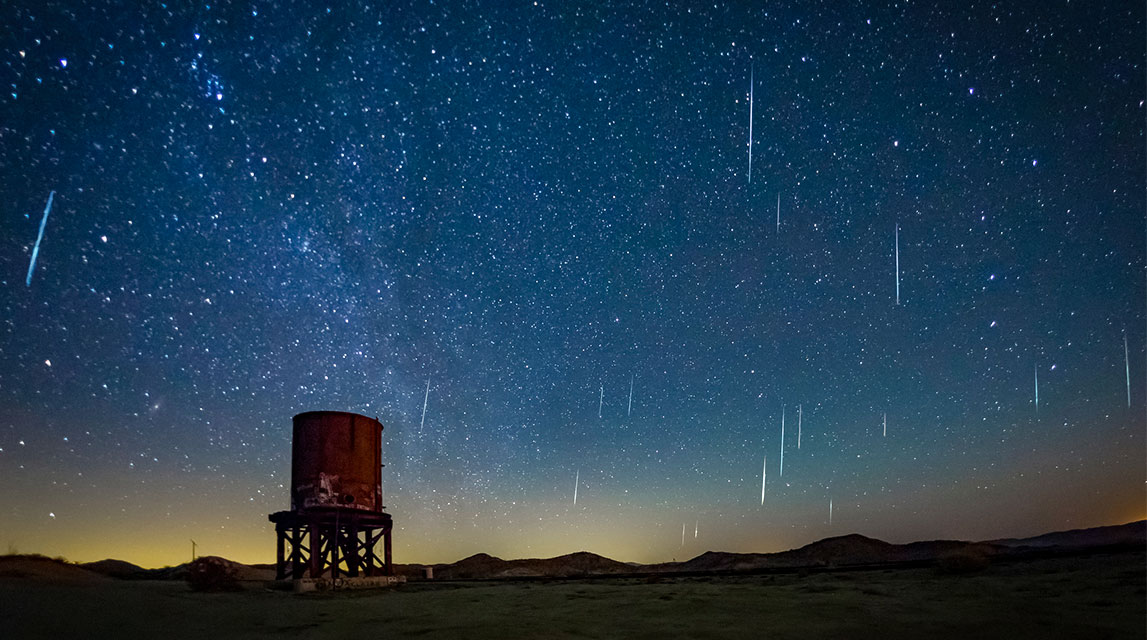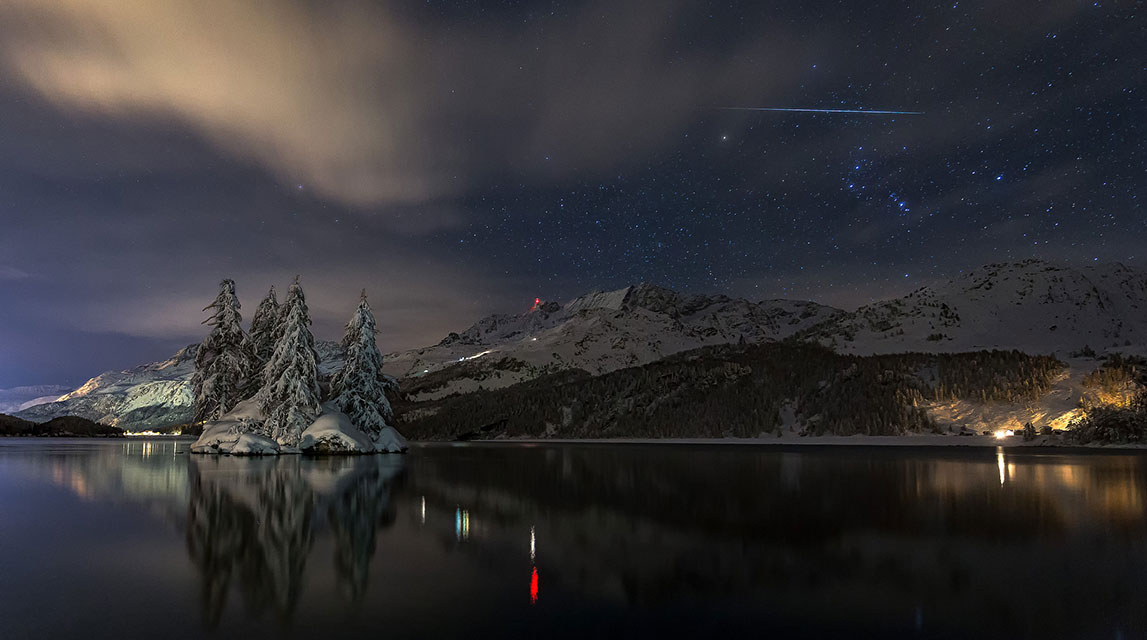
Viewing the eta Aquariids 2018
Eta Aquariid Meteor Shower 2013 -Composite of approximately 50 images containing 26 meteors, meteor train, 17 % moon, zodiacal light…

Eta Aquariid Meteor Shower 2013 -Composite of approximately 50 images containing 26 meteors, meteor train, 17 % moon, zodiacal light…

During this period the moon will reach it's full phase on Monday April 30. At that time the moon will be located opposite the sun and will lie above the horizon all night long. As the week progresses the waning gibbous moon will rise later in the evening but will still seriously impede meteor viewing as the bright glare will obscure all but the brightest meteors.

The estimated total hourly meteor rates for evening observers this week is 2 as seen from mid-northern latitude (45N) and 3 from the southern tropics (25S). For morning observers the estimated total hourly rates should be near 20 as seen from mid-northern latitudes (45N) and 13 from the southern tropics (25S). Evening rates are reduced due to moonlight.

During this period the moon will reach it's new phase on Sunday April 15. At that time the moon will be located near the sun and will not be visible at night. As the week progresses the waxing crescent moon will enter the evening sky but will not cause any interference to meteor observers, especially during the more active morning hours.

On the night of maximum activity (April 21/22) the Lyrid radiant will lie in eastern Hercules, not far from the brilliant white star known as Vega (alpha Lyrae). The Lyrids are usually faint meteors possessing average speeds. Lyrid fireballs are uncommon but do occur on occasion.

During this period the moon will reach it's last quarter phase on Sunday April 8. At that time the moon will be located 90 degrees west of the sun and will rise between 02:00 and 3:00 local daylight saving time (LDT) for observers located in mid-northern latitudes. As the week progresses the waning crescent moon will become less of a problem as it rises later each passing night.

During this period the moon will reach it's full phase on Saturday March 31. At that time it will be located opposite the sun and will remain above the horizon all night long. As the week progresses the waning gibbous moon will rise later in the evening but will still hamper the more active morning hours making meteor observing difficult at best.

During this period the moon will reach it's first quarter phase on Saturday March 24. At that time it will be located 90 degrees east of the sun and will set near 02:00 local daylight saving time. (LDT). As the week progresses the waxing gibbous moon will remain in the sky most of the night and will hamper meteor viewing while still visible.

During this period the moon will reach it's new phase on Saturday March 17. At that time it will be located near the sun and will be invisible at night. As the week progresses the waxing crescent moon will enter the evening sky and will begin to interfere with meteor observations late in the week.

During this period the moon will wane from nearly one-half illuminated to almost new (invisible). This weekend the nearly half illuminated moon will rise near 02:00 local standard time and will interfere with meteor viewing if it lies within your field of view. With each passing night the moon will become a bit thinner and will rise later in the morning providing the meteor observer with a better view of the heavens.

The estimated total hourly meteor rates for evening observers this week is 2 as seen from mid-northern latitude (45N) and 4 from the southern tropics (25S). For morning observers the estimated total hourly rates should be near 3 as seen from mid-northern latitudes (45N) and 6 from the southern tropics (25S).

During this period the moon will reach its full phase on Thursday March 1st. At that time the moon will lie opposite the sun and will lie above the horizon all night long. This weekend the waxing gibbous moon will set shortly after midnight allowing the meteor observer to view under dark conditions the remainder of the night. This window of opportunity will shorten by about an hour with each passing night until the moon lies above the horizon all night long later in the week.

The estimated total hourly meteor rates for evening observers this week is 3 as seen from mid-northern latitude (45N) and 5 from the southern tropics (25S). For morning observers the estimated total hourly rates should be near 6 as seen from mid-northern latitudes (45N) and 13 from the southern tropics (25S).

The estimated total hourly meteor rates for evening observers this week is 3 as seen from mid-northern latitude (45N) and 5 from the southern tropics (25S). For morning observers the estimated total hourly rates should be near 10 as seen from mid-northern latitudes (45N) and 17 from the southern tropics (25S).

February offers the meteor observer in the northern hemisphere a couple of weak showers plus falling sporadic rates. This may not seem too exiting but you never know when surprises are in store. An errant earthgrazer from the Centaurid complex may shoot northward...

For morning observers the estimated total hourly rates should be near 8 as seen from mid-northern latitudes (45N) and 9 from the southern tropics (25S). The actual rates will also depend on factors such as...

The estimated total hourly meteor rates for evening observers this week is 3 as seen from mid-northern latitudes (45N) and 4 from the southern tropics (25S) . For morning observers the estimated total hourly rates should be near 11 as seen from mid-northern latitudes (45N) and 12 from the southern tropics (25S).

The AMS has received over 610 reports so far about of a fireball event seen above Michigan on January 16th, 2018 around 08:10pm EST (January 17th 01:10 Universal Time). The fireball was seen primarily from Michigan but was also seen from Illinois, Pennsylvania, Ohio, Indiana, Missouri and Ontario (Canada).

During this period the moon will reach its new phase on Wednesday January 17th. At that time the moon will lie near the sun and will be invisible at night. This weekend the waning crescent moon will rise during the early morning hours but will not interfere with meteor observing.

During this period the moon will reach its last quarter phase on Monday January 8th. At that time the half-illuminated moon will lie 90 degrees west of the sun and will rise near midnight local standard time (LST) as seen from mid-northern latitudes. This weekend the bright gibbous moon will lie in the sky from about 2200 LST onward. This is make viewing meteor activity difficult as the bright moon will obscure all bu the brighter meteors. As the moon passes last quarter on Tuesday, conditions improve with each passing night. The moon's phase will shrink each night plus the moon will rise later and later.

This will be the worst time to try and view meteor activity as the bright moon will obscure all but the brighter meteors. The estimated total hourly meteor rates for evening observers this week is near 3 as seen from mid-northern latitudes (45N) and 2 as seen from tropical southern locations (25S). For morning observers the estimated total hourly rates should be near 10 as seen from mid-northern latitudes and 7 from the southern tropics.